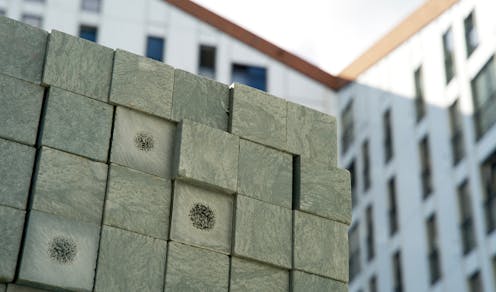
The construction industry accounts for approximately 37% of global CO₂ emissions. Traditional materials like cement, steel, and bricks contribute over 70% of its footprint, with cement production making up an especially large share.
To confront this problem, researchers are developing all manner of innovative construction materials and mechanisms, ranging from walls that produce solar energy to self-repairing bacteria-based concrete.
These smart materials, seemingly the stuff of science fiction, are fast becoming a reality, and a raft of European Union (EU) initiatives aim to turn cutting-edge construction materials into real, sustainable, affordable solutions. The private sector is also playing its part – over the past two decades companies such as Dyson Holdings and Monodraught have filed more than 40 patents for advanced materials aimed at enhancing buildings’ thermal performance, durability and environmental impact.
However, any new material has to clear a lot of safety, security and environmental hurdles. This means that getting them out of the lab and into the real world can present a serious challenge.
From prototype to building site
The development process begins with identifying a technical or environmental issue, such as improving insulation or reducing energy use. A functional prototype is then created and tested under controlled conditions to assess its physical and chemical properties. This includes evaluating compressive strength, water absorption, fire resistance, thermal conductivity and acoustic insulation.
If the prototype shows promise, it then progresses to a pilot production phase, where larger quantities are manufactured to test stability, consistency, and scalability. At the same time, comprehensive technical documentation is prepared.
In the EU, approval is a lengthy and tightly regulated process. Construction materials have to comply with the Construction Products Regulation (EU No 305/2011). This involves obtaining CE (European conformity) marking, submitting a Declaration of Performance (DoP), and adhering to harmonised European standards (EN) established by the European Committee for Standardisation (CEN). These standards ensure products meet criteria related to structural safety, thermal efficiency, moisture resistance and fire behaviour.
Additionally, a Life Cycle Assessment is conducted to evaluate the environmental impact of the material, from the extraction of its component raw materials through to its eventual disposal or recycling. This assessment is crucial for aligning with European policies, and for obtaining green building certifications such as BREEAM and LEED.
Once technical approvals are complete, strategies for production, packaging, distribution and marketing are developed. Performance simulations and digital representations of the material (known as Building Information Modelling or BIM objects) are also created to ensure seamless integration into architectural designs using specialised commercial software.
Leer más: Buildings inspired by worms and grasshoppers: the future of biomimicry in construction
Innovation isn’t easy (or cheap)
This complex process means that many innovative ideas in construction never reach the market. Developers need to follow strict safety, performance, and environmental rules, which often involve costly testing and certifications. At the same time, many research teams face challenges like limited funding or industry contacts, and they may not fully understand the legal requirements. Without the right support, even the best ideas can stay stuck as prototypes.
To address these challenges, the European Union has launched several initiatives to push innovations from the initial research phase to market adoption:
Horizon Europe funds research and development in sustainability and energy efficiency.
New European Bauhaus promotes inclusive, green, and accessible urban spaces.
The LIFE Programme supports environmental and climate action projects.
The Green Deal and Renovation Wave aim to decarbonise buildings and promote a circular economy.
Leer más: 'Urban form' and the housing crisis: Can streets and buildings make a neighbourhood more affordable?
A gateway to future materials
Bridging the gap between prototypes and market-ready construction materials requires comprehensive support. Exploit4InnoMat is a European platform offering a Single-Entry Point for entrepreneurs, SMEs and research centers aiming to scale smart, sustainable materials.
The platform provides services encompassing the entire development cycle:
Technical validation and certification: Access to EU-approved pilot line facilities for testing according to European standards, including the aforementioned CE marking and Declaration of Performance (DoP).
Specialised scientific advice: Support in material characterisation, property optimisation, and scaling strategies.
Simulation and digital modelling: Tools that predict how materials behave in terms of heat, strength, and environmental impact within digital models of real buildings. These tools help create models that can be directly inserted into BIM platforms.
Legal and intellectual property support: Assistance with patent registration and regulatory compliance.
Through this comprehensive approach, Exploit4InnoMat has already brought several new materials to market. These innovations not only enhance energy efficiency, but also minimise environmental impact and extend the lifespan of buildings. Some prominent examples include:
Ceramic panels with phase change materials (PCM), which store and release heat, maintaining stable indoor temperatures and reducing the need for heating and cooling.
Nanotechnology coatings offering antibacterial and reflective properties. These coatings are ideal for hospitals and schools, particularly in hot climates where hygiene and energy efficiency are paramount.
Recycled cement panels made from industrial waste, which reduce the use of virgin raw materials and lower emissions in production.
Optimised Ceramic Elements, such as bricks and tiles improved with additives, recycled materials, and nanotechnology to boost insulation, porosity, and sustainability.
Schemes like Exploit4InnoMat play a crucial role by integrating all development phases into a single platform. From laboratory testing and environmental validation through to market entry, they assist developers in accelerating their innovations in the knowledge that they stand a solid chance of actually being used in construction.
Materials that previously stalled at the prototype stage now have a much clearer pathway to real-world application. This streamlined process ensures that scientific advancements reach our built environment more rapidly, contributing to the creation of greener, more efficient cities prepared for future challenges.
Andrés Jonathan Guízar Dena participates as a researcher in the Exploit4InnoMat project, funded by the European Union. Within the project, he provides advisory and product characterisation services for digital modelling, including BIM environments and energy simulation.
This article was originally published on The Conversation. Read the original article.







